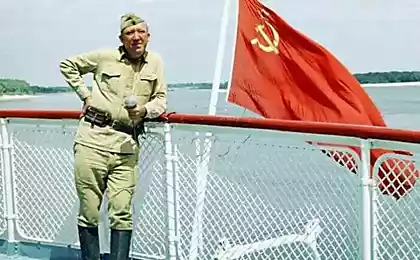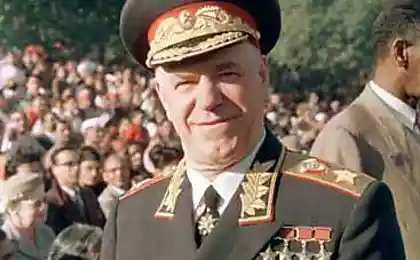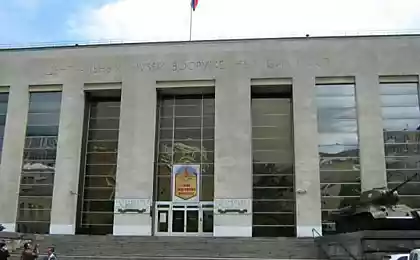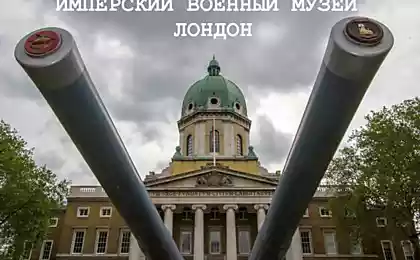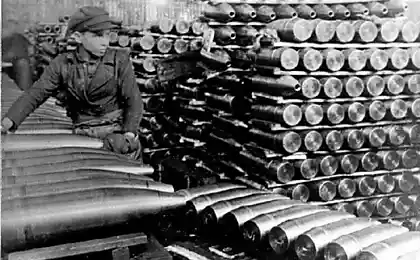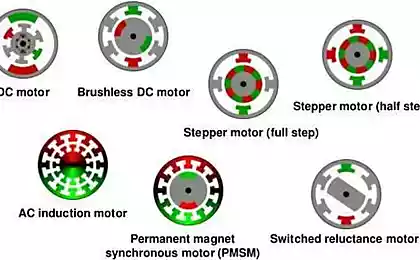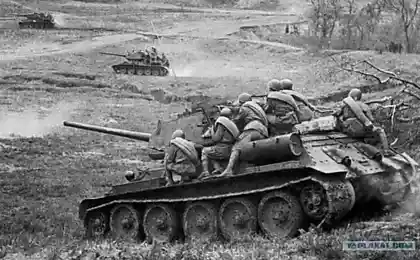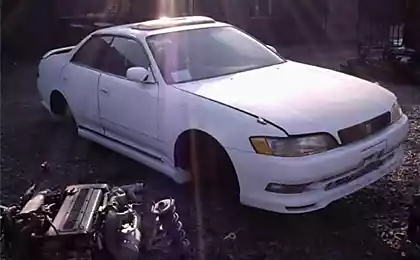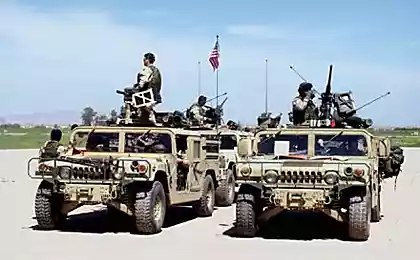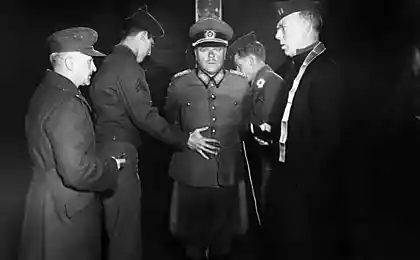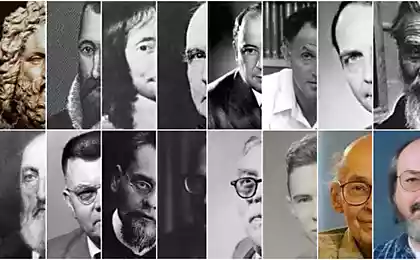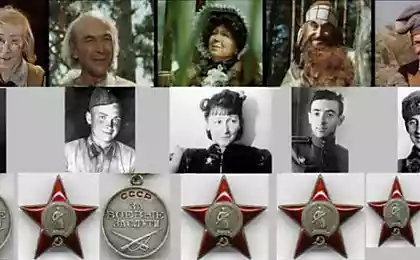1293
Legendary "Klim Voroshilov" - War Machine
In accordance with the decision of the Committee of Defense of the USSR in late 1938, SKB-2 Kirov factory in Leningrad (chief designer J. J. Kotin) began designing new heavy tank with protivosnaryadnym book, called SMC (Sergei Kirov). The development of yet another heavy tank, named T-100, Leningrad plant experienced studied Mechanical Engineering. Kirov (plant number 185). In parallel with the QMS developed a draft odnobashennogo heavy tank KV.
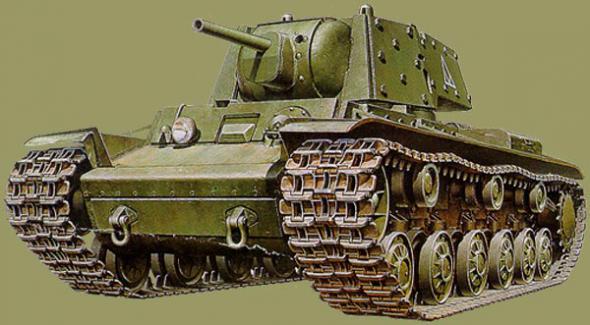
Lead designer SMK tank was A. Ermolaev.
The initial draft provided for a three-turret machines weighing 55 tons. In operation from one tower abandoned, saved and sent to thickening of the weight of armor.
In parallel with the QMS group graduate of the Military Academy of Mechanization and Motorization them. Stalin was an intern at the Kirov factory, under the leadership of LE Sychev and A. Ermolaeva drafted odnobashennogo heavy tank KV ("Klim Voroshilov»).
In fact HF was a decrease in the length of the two supporting roller QMS with a single tower and a diesel engine. At the final stage of design odnobashennogo tank leading designer of the project he was assigned NL Spirit.
Heavy Tank KV-1A raised from the bottom of the Neva River in spring 2003
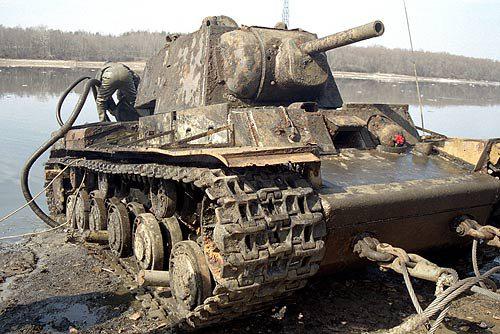
In August 1939, KV was made in the metal, and in late September, participated in the presentation of new models of armored vehicles on NIBT range in Kubinka. In October, we began production tests. In November, the first prototype of the tank was sent to the front on the Karelian Isthmus to take part in military operations against the Finns. December 19 1939 KV was adopted by the Red Army.
Serial production of KV tanks with 76 mm cannons ("tanks with a small tower") and quickly developed from the experience of fighting on the Mannerheim Line KV tanks with 152mm howitzers ("tanks with a large tower") began in February 1940 at the Leningrad Kirov Plant (LB). Until the end, the Kirov factory managed to produce 243 tanks (139 KV-1 and KV-2 104), fully implementing top-down plan. In accordance with the decision of SNK and the Central Committee of the CPSU (b) on June 19, 1940 to release HF should connect and Chelyabinsk Tractor Plant (CTZ). December 31, 1940 was made a pilot assembly of the first production of HF Urals. At the same time in Chelyabinsk began construction of a special building for the assembly of heavy tanks.

The production plan for 1941 called for the release of 1,200 tanks KV. Of these, at the Kirov plant - 1000, at CTZ - 200. However, the war has made adjustments to the plan. By the beginning of the war in Chelyabinsk produced only 25 KV-1 and KV-2 production has not been mastered. In total in the first half of 1941 were made 393 KV.
Corpus KV-1 tank welded from rolled armor plates, which reached the maximum thickness of 75 mm. The tower was made in two versions - welded and molded. The maximum thickness of armor welded towers reached 75 mm cast - 95 mm. In 1941, the thickness of the armor welded towers adjusted to 105 mm by installing the 25-mm screens are fastened with screws.
On tanks first release fixes a 76-mm gun L-11, then - the F-32 of the same caliber as the end of October 1941 - the 76-mm gun ZIS-5. In addition, the tank was armed with three machine guns - paired, foreign exchange and fodder. On the part of the machine is installed and anti-aircraft machine gun DT. Ammunition consisted of 135 cannon rounds and 2772 rounds of ammunition for machine guns.
This tank KV-2 was stopped just hit the projectile to the left caterpillar
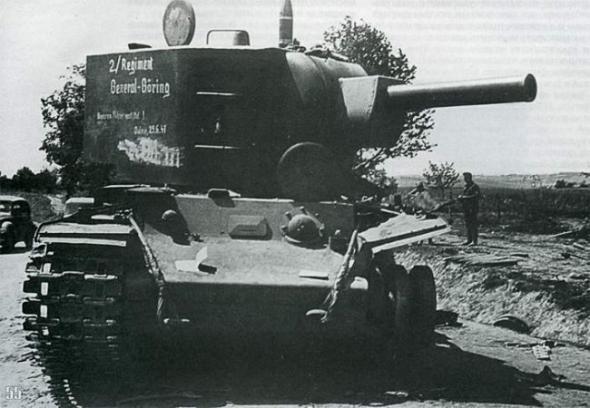
12-cylinder V-diesel V-2K capacity of 600 liters. from. allow 47 5-ton combat vehicle to reach speeds of 34 km / h. Cruising on the highway is 250 km. The crew consisted of five people.
The main difference between the KV-2 is to install a new tower large size. The overall height of the machine reached 3240 mm. The tower, in the mask outside the closed armored casing, installed 152 mm Tank Howitzer M-10's sample 1938-1940 and the coaxial machine gun DT. At the stern of the tower there was a door, next to which was placed in a ball bearing another DT. The tank also kept exchange machine gun in front hull. Ammunition consisted of 36 rounds of separate loading and 3087 rounds. The power plant, power train, chassis, electrical and radio equipment remained the same as in the KV-1. KV-2 was produced in a limited number, and after the start of World War II from July 1, 1941 its production stopped.
KV-1

As of June 1, 1941, the army had 504 KV. Of this amount, a large part was in the Kiev Special Military District - 278 cars. Western special military district has 116 tanks KV, Baltic Special - 59, Odessa - 10. In the Leningrad Military District had 6 KV tanks in Moscow - 4, in the Volga - 19, Orel - 8, in Kharkov - 4. Of this amount, It was in operation 75 KV-1 and KV-2 9. From 1 to June 21, troops from the factory was still recovering 41 KV.
Crew training for new heavy tanks are often conducted (if not conducted) on all types of tanks. For example, December 3, 1940 directive Chief of General Staff of the Red Army № 5/4/370 ordered "for training of personnel and material savings of the combat vehicles released exclusively as training, each battalion of heavy tanks and 10 tankettes T-27." It remains a mystery, as the T-27 could learn driving and maintenance of KV-1 or KV-2. As a result, by June 1941 the number of trained crews for these machines does not exceed 150.
In the early days of World War II in the fully emerged as the obvious advantages and disadvantages of new heavy tanks, as well as all shortcomings in combat training and organizational structure of the armored forces of the Red Army. For example, in the report on the fighting of the 8th Mechanized Corps from 22 to 26 June 1941 (the beginning of the war, the Corps had 71 KB, 49 T-35, 100 T-34, 277 BT, 344 T-26, 17, T-27) reported the following: "The driving part of a KB and combat vehicles T-34 mostly had practical experience of driving from 3 to 5 hours. Over the entire period of existence of the body combat materiel and personnel completely on tactical exercises are not displayed and has not been practically verified as preparation for the march, and for action in the main types of combat. Tactical cohesiveness carried no higher scale company, battalion and regiment partly ».
From the report of the commander of the 41st Panzer Division 22th Mechanized Corps on July 25, 1941 on the combat division (at the beginning of the war there were 312 tanks T-26 and KV-31, 2) that a 152-mm gun KV- 2 did not have a single shell.
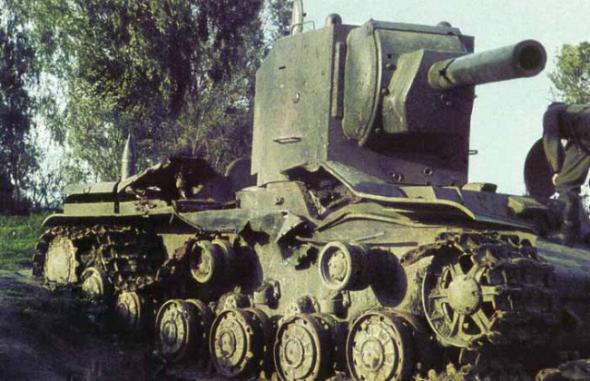
According to the memoirs D. Osadchy, commander of a company of tanks KV-1 in the 2nd Armored Division, "June 23-24, before joining the battle, many tanks KB, especially HF-2, out of order during the march. It was a big problem with the gearbox and air filters. June was hot, the dust on the roads of the Baltic states, and a huge number of filters had to be replaced after an hour and a half of operation. Before going into battle tanks of my company we were able to replace them, and in the neighboring - not. As a result, by mid-day the majority of machines in these battalions broken ».
Very well trained crews worked on the tanks KV wonders. August 18, 1941, five tanks KV-1 company of lieutenant ZG Kolobanova took up defensive positions on the approaches to the city Krasnogvardeisk (Gatchina). By evening, the tanks were hidden in the tower caponiers. For its HF Kolobanov chosen position on the most endangered area - the northern outskirts Krasnogvardeisk. Advancing here of the 1st Panzer Division could strike the rear of Soviet troops take up defensive positions on the borders Krasnogvardeisky fortified area, and then went out on the old Gatchina Park in Kiev highway, almost seamlessly move to Leningrad.
On the morning of August 19 on the left one of the tanks company engaged in battle with the enemy. In the second hour of the day German tanks appeared before Kolobanova position. 22 enemy vehicles were on the road in the column shortening the distance, putting the left side of his almost strictly at right angles to the gun KV. Hatches were opened, many Germans were on the armor. Our tankers even distinguish their faces, as the distance to the enemy column was small - only about 150 m. As to the landmark number 1 (two birches at the crossroads), scheduled tankers the day before, it was only a few meters Kolobanov ordered the commander of guns Sergeant Usov open fire. Several shots Usov set fire to two head end and two enemy tanks. The column was in the bag. The maneuver was limited by the Germans to wetlands on both sides of the road. The enemy was not immediately identified, where is the fire, but then brought down to the position Kolobanova rain of shells. Tankers choked with powder gases from the blows of enemy tank shells of armor were all shell-shocked. Usov, not looking up from the sight, went to shoot the tank for tank. Finally, the last 22 minutes the tank was destroyed. During the battle, which lasted more than an hour, Usov issued 98 rounds at the enemy. For this fight Kolobanov senior lieutenant was awarded the Order of the Red Banner, and Sergeant Usov - the Order of Lenin.

In the same battle, and distinguished from other crews HF Kolobanova company. In the battle on the Kaluga road crew Lieutenant Sergeeva knocked out 8 of the German tanks, the crew of Lieutenant Swallow and second lieutenant Degtyar - 4, and the crew of the second lieutenant Evdokimenko - 5. This Evdokimenko killed in action and three crew members were injured, and the fifth tank mechanic -voditel Sidikov destroyed ramming attack. Total for August 19, 1941 Kolobanova company put out of action 43 German tanks.
As for the rams, often described in various media, the summer of 1941 they were indeed frequent, but sometimes not a good life. That's what was reported in the report of the commander of the 43rd Panzer Division 19th Mechanized Corps of the battles from June 22 to August 10, 1941: "In pursuit of the enemy infantry, our tanks were met with fire enemy tanks in an ambush from a place, but (the ambush) was attacked get ahead tanks KB and T-34, and after them, and the T-26 ... Tanks KB and T-34 without a sufficient number of armor-piercing projectiles, fired shrapnel shells and their weight pressed and destroy enemy tanks and anti-tank guns, moving from one milestone to another ».
However, despite the powerful armor, heavily armed, and the heroism of the individual crews, tanks KB did not play in the summer battles in 1941 no significant role. Most of these machines out of service for technical reasons, because of the illiterate operation, lack of spare parts, repair and evacuation means. In addition, the Germans found out that the fight conventional antitank weapons with KB impossible successfully used against them 88-mm anti-aircraft gun Flak 36 and 105 mm (in German notation - 10 cm) housing field guns K18.
Nevertheless, the documents fall of 1941, there are reports of very successful use of tanks KV. However, mainly in the defense. For example, 8 November 1941, the crew of the KV Lieutenant Alexander Martynov of the 16th Tank Brigade Volkhov front in the battle near the village of Zhupkino (Leningrad region), reflected in an ambush attack of 14 German tanks, killing five and capturing as trophies three German cars. Soon, these tanks have been renovated and have fought in the 16th Tank Brigade. For this fight Lieutenant Martynov presented the title of Hero of the Soviet Union. December 5, 1941 the crew of the KV-1 Lt. Paul Gudz of the 89th tank battalion entered into battle with 18 German tanks, knocked out 10 of them, as well as four anti-tank guns. For this fight Hutz was awarded the Order of Lenin. I must say that this tank KV tanker knew perfectly well, as it began to fight in the first days of the Great Patriotic War. His further fate of the battle is also associated with the war machines of this type.

In July 1942, Paul Hutz has the rank of captain, he was appointed commander of the 574 th Tank Battalion 212th Tank Brigade, part of the forces of the Don front. In November of the same year, he was given the rank of captain Hutz Major and was appointed deputy commander of the 8th Guards Tank Regiment separate breakout. However, for a long time in this position, he was unable to serve, as early as next month, was injured.
In one of the fights of his tank caught fire. Besides flew caterpillar war machine and froze. And the armor is already buzzing from the flames broke out of diesel, threatening to get inside the car, packed with ammunition. Came to the rescue tank crews rescued the crew and their commander with six penetrating wounds rushed to the hospital. After such wounds in the combat system will not be returned. But Major wrote a report to the High Commander in Chief and got his - was sent to the front.
The new duty station Major Gudz became the 5th Guards Tank Regiment separate breakout, who was a member of the South-West (later the 3rd Ukrainian) front, in which he in May 1943 took the post of deputy commander. When approaching the Zaporozhye to ensure infantry units crossing of the Dnieper, it was necessary to capture the hydroelectric dam. For two days there was a fierce battle. When our tanks reached the target of an ambush suddenly popped "Tiger". Gun duel ensued. Suddenly the tank, which was Hutz, shook a huge blow force. Loader and gunner were killed. Gudz have been damaged left collarbone and fractured left hand she hung on one vein. Pain clouded consciousness, and in the sight of "Tigers" blurred as water bright spots diesel. Overcoming the pain, Hutz Colonel Fincke cut his tendon. Brush slipped out of the suit. Now all the attention is "tiger". Here's a framed board. Obediently worked pedal descent. From firing tank started - and enemy vehicles in flames, came to a standstill on the sandbar. The second "Tiger" still managed to deploy his gun, and saw a black circle Hutz her trunk. "Tiger" KB and shot at each other almost simultaneously ...
KV-2 exploded with MT-1. In the background, another HF-2
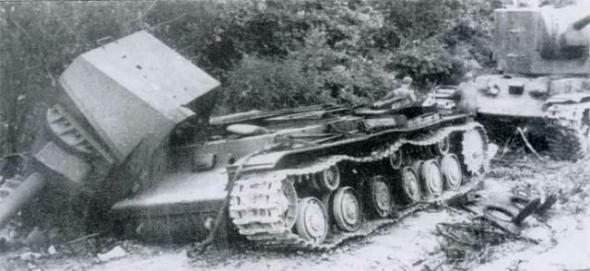
When he came to consciousness realized that it is evening and the fight goes the distance, and he was lying about the tank, in a fresh bomb crater. Close on his heels sitting driver. Noting that the commander came to, joyfully announced: "And the second you too ...»
The reader probably immediately arises a question: whether "Tigers"? In fact, after the Battle of Kursk reckoning almost any German tank to the "tiger" class in the Red Army became a mass phenomenon. Well, we can say firmly - "Tigers" were! It was at this time and in this place, in the vicinity of the dam the Dnieper led battles 506 th German heavy tank battalion. Of course HF, frankly, is not "pulled" against the "Tiger" tank in a duel, but as described battle was fought at close range, the chances are aligned. But such an experienced tankers Paul Hutz nothing should hit the "Tiger" with the first shot. So it's safe to say that in this battle, it really knocked out two "Tiger", and from a broken tank and severed his left hand! The fact that the war diary 506 th German heavy tank battalion, we probably will not find any evidence of this, absolutely nothing - Germans take into account only their irrevocable loss, lined the tanks in their reports do not appear.
It should be emphasized that the mere tank KB - machine rather contradictory fate. Paradoxical as it may sound, but in 1941, this tank was not necessary - it just was not a worthy opponent. No fighting is obvious advantages over the average T-34, except thicker armor, he had not. Armament was the same maneuverability as worse than the Thirty. Tankers are not very fond of this car: KB three sheets could break either way (wheeled vehicles to follow him could not), it was unable to withstand almost none of the bridge, except for the capital of stone. But the main drawback - highly unreliable transmission, the output of which has been out of action a mass phenomenon.
Some shortcomings were eliminated in the transmission appeared in 1942 modifying the KV-1S ("s" - speed). However, in this modification, in the pursuit of maneuver to reduce the thickness of armor, and his fighting properties of heavy KB even closer to the medium tank.
Thus, the only justification for the release KB in 1941-1942 along with the T-34 could only be more powerful gun, for example 85 mm. But this was not done for the reason that at that time 76 mm gun, copes with all bronetselyami opponent.
Captured by the Germans HF 2. German Mechanized Division on the march
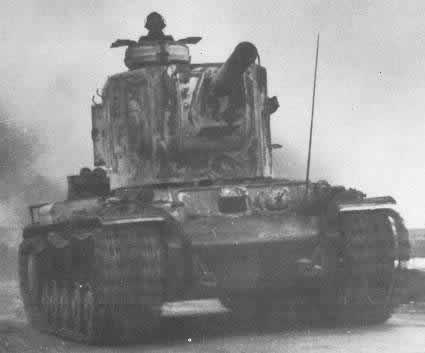
Tank similar KB class - "Tiger" came from the Germans until the end of 1942. And then fate played a cruel joke KB second - he instantly obsolete.
Source:

Lead designer SMK tank was A. Ermolaev.
The initial draft provided for a three-turret machines weighing 55 tons. In operation from one tower abandoned, saved and sent to thickening of the weight of armor.
In parallel with the QMS group graduate of the Military Academy of Mechanization and Motorization them. Stalin was an intern at the Kirov factory, under the leadership of LE Sychev and A. Ermolaeva drafted odnobashennogo heavy tank KV ("Klim Voroshilov»).
In fact HF was a decrease in the length of the two supporting roller QMS with a single tower and a diesel engine. At the final stage of design odnobashennogo tank leading designer of the project he was assigned NL Spirit.
Heavy Tank KV-1A raised from the bottom of the Neva River in spring 2003

In August 1939, KV was made in the metal, and in late September, participated in the presentation of new models of armored vehicles on NIBT range in Kubinka. In October, we began production tests. In November, the first prototype of the tank was sent to the front on the Karelian Isthmus to take part in military operations against the Finns. December 19 1939 KV was adopted by the Red Army.
Serial production of KV tanks with 76 mm cannons ("tanks with a small tower") and quickly developed from the experience of fighting on the Mannerheim Line KV tanks with 152mm howitzers ("tanks with a large tower") began in February 1940 at the Leningrad Kirov Plant (LB). Until the end, the Kirov factory managed to produce 243 tanks (139 KV-1 and KV-2 104), fully implementing top-down plan. In accordance with the decision of SNK and the Central Committee of the CPSU (b) on June 19, 1940 to release HF should connect and Chelyabinsk Tractor Plant (CTZ). December 31, 1940 was made a pilot assembly of the first production of HF Urals. At the same time in Chelyabinsk began construction of a special building for the assembly of heavy tanks.

The production plan for 1941 called for the release of 1,200 tanks KV. Of these, at the Kirov plant - 1000, at CTZ - 200. However, the war has made adjustments to the plan. By the beginning of the war in Chelyabinsk produced only 25 KV-1 and KV-2 production has not been mastered. In total in the first half of 1941 were made 393 KV.
Corpus KV-1 tank welded from rolled armor plates, which reached the maximum thickness of 75 mm. The tower was made in two versions - welded and molded. The maximum thickness of armor welded towers reached 75 mm cast - 95 mm. In 1941, the thickness of the armor welded towers adjusted to 105 mm by installing the 25-mm screens are fastened with screws.
On tanks first release fixes a 76-mm gun L-11, then - the F-32 of the same caliber as the end of October 1941 - the 76-mm gun ZIS-5. In addition, the tank was armed with three machine guns - paired, foreign exchange and fodder. On the part of the machine is installed and anti-aircraft machine gun DT. Ammunition consisted of 135 cannon rounds and 2772 rounds of ammunition for machine guns.
This tank KV-2 was stopped just hit the projectile to the left caterpillar

12-cylinder V-diesel V-2K capacity of 600 liters. from. allow 47 5-ton combat vehicle to reach speeds of 34 km / h. Cruising on the highway is 250 km. The crew consisted of five people.
The main difference between the KV-2 is to install a new tower large size. The overall height of the machine reached 3240 mm. The tower, in the mask outside the closed armored casing, installed 152 mm Tank Howitzer M-10's sample 1938-1940 and the coaxial machine gun DT. At the stern of the tower there was a door, next to which was placed in a ball bearing another DT. The tank also kept exchange machine gun in front hull. Ammunition consisted of 36 rounds of separate loading and 3087 rounds. The power plant, power train, chassis, electrical and radio equipment remained the same as in the KV-1. KV-2 was produced in a limited number, and after the start of World War II from July 1, 1941 its production stopped.
KV-1

As of June 1, 1941, the army had 504 KV. Of this amount, a large part was in the Kiev Special Military District - 278 cars. Western special military district has 116 tanks KV, Baltic Special - 59, Odessa - 10. In the Leningrad Military District had 6 KV tanks in Moscow - 4, in the Volga - 19, Orel - 8, in Kharkov - 4. Of this amount, It was in operation 75 KV-1 and KV-2 9. From 1 to June 21, troops from the factory was still recovering 41 KV.
Crew training for new heavy tanks are often conducted (if not conducted) on all types of tanks. For example, December 3, 1940 directive Chief of General Staff of the Red Army № 5/4/370 ordered "for training of personnel and material savings of the combat vehicles released exclusively as training, each battalion of heavy tanks and 10 tankettes T-27." It remains a mystery, as the T-27 could learn driving and maintenance of KV-1 or KV-2. As a result, by June 1941 the number of trained crews for these machines does not exceed 150.
In the early days of World War II in the fully emerged as the obvious advantages and disadvantages of new heavy tanks, as well as all shortcomings in combat training and organizational structure of the armored forces of the Red Army. For example, in the report on the fighting of the 8th Mechanized Corps from 22 to 26 June 1941 (the beginning of the war, the Corps had 71 KB, 49 T-35, 100 T-34, 277 BT, 344 T-26, 17, T-27) reported the following: "The driving part of a KB and combat vehicles T-34 mostly had practical experience of driving from 3 to 5 hours. Over the entire period of existence of the body combat materiel and personnel completely on tactical exercises are not displayed and has not been practically verified as preparation for the march, and for action in the main types of combat. Tactical cohesiveness carried no higher scale company, battalion and regiment partly ».
From the report of the commander of the 41st Panzer Division 22th Mechanized Corps on July 25, 1941 on the combat division (at the beginning of the war there were 312 tanks T-26 and KV-31, 2) that a 152-mm gun KV- 2 did not have a single shell.

According to the memoirs D. Osadchy, commander of a company of tanks KV-1 in the 2nd Armored Division, "June 23-24, before joining the battle, many tanks KB, especially HF-2, out of order during the march. It was a big problem with the gearbox and air filters. June was hot, the dust on the roads of the Baltic states, and a huge number of filters had to be replaced after an hour and a half of operation. Before going into battle tanks of my company we were able to replace them, and in the neighboring - not. As a result, by mid-day the majority of machines in these battalions broken ».
Very well trained crews worked on the tanks KV wonders. August 18, 1941, five tanks KV-1 company of lieutenant ZG Kolobanova took up defensive positions on the approaches to the city Krasnogvardeisk (Gatchina). By evening, the tanks were hidden in the tower caponiers. For its HF Kolobanov chosen position on the most endangered area - the northern outskirts Krasnogvardeisk. Advancing here of the 1st Panzer Division could strike the rear of Soviet troops take up defensive positions on the borders Krasnogvardeisky fortified area, and then went out on the old Gatchina Park in Kiev highway, almost seamlessly move to Leningrad.
On the morning of August 19 on the left one of the tanks company engaged in battle with the enemy. In the second hour of the day German tanks appeared before Kolobanova position. 22 enemy vehicles were on the road in the column shortening the distance, putting the left side of his almost strictly at right angles to the gun KV. Hatches were opened, many Germans were on the armor. Our tankers even distinguish their faces, as the distance to the enemy column was small - only about 150 m. As to the landmark number 1 (two birches at the crossroads), scheduled tankers the day before, it was only a few meters Kolobanov ordered the commander of guns Sergeant Usov open fire. Several shots Usov set fire to two head end and two enemy tanks. The column was in the bag. The maneuver was limited by the Germans to wetlands on both sides of the road. The enemy was not immediately identified, where is the fire, but then brought down to the position Kolobanova rain of shells. Tankers choked with powder gases from the blows of enemy tank shells of armor were all shell-shocked. Usov, not looking up from the sight, went to shoot the tank for tank. Finally, the last 22 minutes the tank was destroyed. During the battle, which lasted more than an hour, Usov issued 98 rounds at the enemy. For this fight Kolobanov senior lieutenant was awarded the Order of the Red Banner, and Sergeant Usov - the Order of Lenin.

In the same battle, and distinguished from other crews HF Kolobanova company. In the battle on the Kaluga road crew Lieutenant Sergeeva knocked out 8 of the German tanks, the crew of Lieutenant Swallow and second lieutenant Degtyar - 4, and the crew of the second lieutenant Evdokimenko - 5. This Evdokimenko killed in action and three crew members were injured, and the fifth tank mechanic -voditel Sidikov destroyed ramming attack. Total for August 19, 1941 Kolobanova company put out of action 43 German tanks.
As for the rams, often described in various media, the summer of 1941 they were indeed frequent, but sometimes not a good life. That's what was reported in the report of the commander of the 43rd Panzer Division 19th Mechanized Corps of the battles from June 22 to August 10, 1941: "In pursuit of the enemy infantry, our tanks were met with fire enemy tanks in an ambush from a place, but (the ambush) was attacked get ahead tanks KB and T-34, and after them, and the T-26 ... Tanks KB and T-34 without a sufficient number of armor-piercing projectiles, fired shrapnel shells and their weight pressed and destroy enemy tanks and anti-tank guns, moving from one milestone to another ».
However, despite the powerful armor, heavily armed, and the heroism of the individual crews, tanks KB did not play in the summer battles in 1941 no significant role. Most of these machines out of service for technical reasons, because of the illiterate operation, lack of spare parts, repair and evacuation means. In addition, the Germans found out that the fight conventional antitank weapons with KB impossible successfully used against them 88-mm anti-aircraft gun Flak 36 and 105 mm (in German notation - 10 cm) housing field guns K18.
Nevertheless, the documents fall of 1941, there are reports of very successful use of tanks KV. However, mainly in the defense. For example, 8 November 1941, the crew of the KV Lieutenant Alexander Martynov of the 16th Tank Brigade Volkhov front in the battle near the village of Zhupkino (Leningrad region), reflected in an ambush attack of 14 German tanks, killing five and capturing as trophies three German cars. Soon, these tanks have been renovated and have fought in the 16th Tank Brigade. For this fight Lieutenant Martynov presented the title of Hero of the Soviet Union. December 5, 1941 the crew of the KV-1 Lt. Paul Gudz of the 89th tank battalion entered into battle with 18 German tanks, knocked out 10 of them, as well as four anti-tank guns. For this fight Hutz was awarded the Order of Lenin. I must say that this tank KV tanker knew perfectly well, as it began to fight in the first days of the Great Patriotic War. His further fate of the battle is also associated with the war machines of this type.

In July 1942, Paul Hutz has the rank of captain, he was appointed commander of the 574 th Tank Battalion 212th Tank Brigade, part of the forces of the Don front. In November of the same year, he was given the rank of captain Hutz Major and was appointed deputy commander of the 8th Guards Tank Regiment separate breakout. However, for a long time in this position, he was unable to serve, as early as next month, was injured.
In one of the fights of his tank caught fire. Besides flew caterpillar war machine and froze. And the armor is already buzzing from the flames broke out of diesel, threatening to get inside the car, packed with ammunition. Came to the rescue tank crews rescued the crew and their commander with six penetrating wounds rushed to the hospital. After such wounds in the combat system will not be returned. But Major wrote a report to the High Commander in Chief and got his - was sent to the front.
The new duty station Major Gudz became the 5th Guards Tank Regiment separate breakout, who was a member of the South-West (later the 3rd Ukrainian) front, in which he in May 1943 took the post of deputy commander. When approaching the Zaporozhye to ensure infantry units crossing of the Dnieper, it was necessary to capture the hydroelectric dam. For two days there was a fierce battle. When our tanks reached the target of an ambush suddenly popped "Tiger". Gun duel ensued. Suddenly the tank, which was Hutz, shook a huge blow force. Loader and gunner were killed. Gudz have been damaged left collarbone and fractured left hand she hung on one vein. Pain clouded consciousness, and in the sight of "Tigers" blurred as water bright spots diesel. Overcoming the pain, Hutz Colonel Fincke cut his tendon. Brush slipped out of the suit. Now all the attention is "tiger". Here's a framed board. Obediently worked pedal descent. From firing tank started - and enemy vehicles in flames, came to a standstill on the sandbar. The second "Tiger" still managed to deploy his gun, and saw a black circle Hutz her trunk. "Tiger" KB and shot at each other almost simultaneously ...
KV-2 exploded with MT-1. In the background, another HF-2

When he came to consciousness realized that it is evening and the fight goes the distance, and he was lying about the tank, in a fresh bomb crater. Close on his heels sitting driver. Noting that the commander came to, joyfully announced: "And the second you too ...»
The reader probably immediately arises a question: whether "Tigers"? In fact, after the Battle of Kursk reckoning almost any German tank to the "tiger" class in the Red Army became a mass phenomenon. Well, we can say firmly - "Tigers" were! It was at this time and in this place, in the vicinity of the dam the Dnieper led battles 506 th German heavy tank battalion. Of course HF, frankly, is not "pulled" against the "Tiger" tank in a duel, but as described battle was fought at close range, the chances are aligned. But such an experienced tankers Paul Hutz nothing should hit the "Tiger" with the first shot. So it's safe to say that in this battle, it really knocked out two "Tiger", and from a broken tank and severed his left hand! The fact that the war diary 506 th German heavy tank battalion, we probably will not find any evidence of this, absolutely nothing - Germans take into account only their irrevocable loss, lined the tanks in their reports do not appear.
It should be emphasized that the mere tank KB - machine rather contradictory fate. Paradoxical as it may sound, but in 1941, this tank was not necessary - it just was not a worthy opponent. No fighting is obvious advantages over the average T-34, except thicker armor, he had not. Armament was the same maneuverability as worse than the Thirty. Tankers are not very fond of this car: KB three sheets could break either way (wheeled vehicles to follow him could not), it was unable to withstand almost none of the bridge, except for the capital of stone. But the main drawback - highly unreliable transmission, the output of which has been out of action a mass phenomenon.
Some shortcomings were eliminated in the transmission appeared in 1942 modifying the KV-1S ("s" - speed). However, in this modification, in the pursuit of maneuver to reduce the thickness of armor, and his fighting properties of heavy KB even closer to the medium tank.
Thus, the only justification for the release KB in 1941-1942 along with the T-34 could only be more powerful gun, for example 85 mm. But this was not done for the reason that at that time 76 mm gun, copes with all bronetselyami opponent.
Captured by the Germans HF 2. German Mechanized Division on the march

Tank similar KB class - "Tiger" came from the Germans until the end of 1942. And then fate played a cruel joke KB second - he instantly obsolete.
Source:



